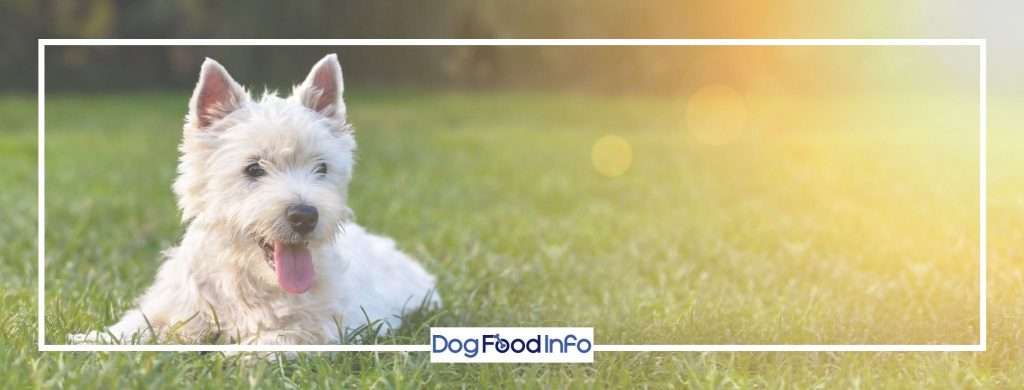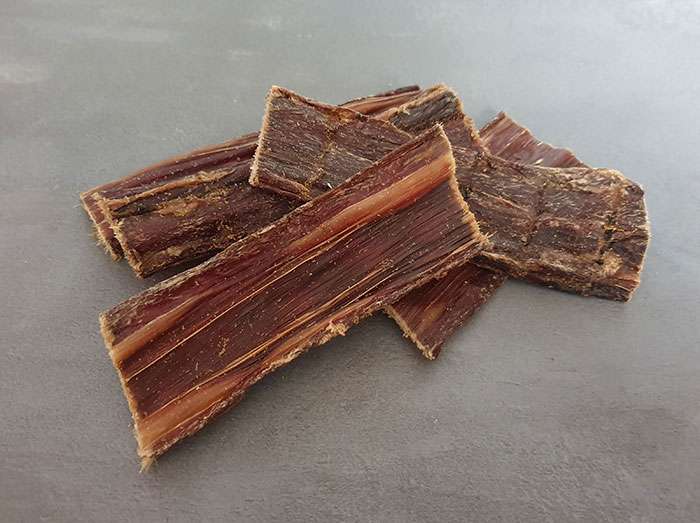
As the name implies, cattle head skin is an air-dried, hardened scalp of cattle.
It can be purchased in various forms: with fur, without fur, in stripes, pieces or as a plate.
In general, cattle head skin can be purchased in any pet shop or pet online store. You will usually find them shrink wrapped in foil. However, more and more pet shops are offering dry meat as a form of self-service.
When dried, cattle head skin is relatively odourless, especially compared to other dog snacks. In this respect, there is no need for separate storage.
However, your four-legged friend is enjoying their snack, a distinct smell can occur! So, be prepared for that!
Benefits of Cattle Head Skin for a Dog
As every dog owner knows, dogs have an inherent need for chewing.
In the dog food trade, there is a vast selection of “chewing snacks” on offer.
From shaped bones (with all sorts of ingredients) to chewing roots, everything can be found on the shelves of pet shops.
However, they often contain additives that bring no benefit to the dog. In contrast, cattle head skin is a pure natural product and offers long-lasting chewing fun.
This not only satisfies the need to chew, but also releases happy hormones, so as a result for example, stress is reduced.
Therefore, it is also appropriate in stressful situations, to let the dog chew something to help through this situation.
Is Cattle Head Skin Suitable for all Dogs?
As the cattle head skin is available in various forms and dosages, there is something for every dog.
No matter how big, small, hard or the soft pieces. Even the slightly softer head skin is very resistant, so your dogs will definitely be busy for a while.
The fact that the bovine head skin can be bought with fur, among other things, causes concern among some dog owners. However, the coat also fulfils a practical purpose: it has a stomach-cleansing effect and is also an extremely natural way of nutrition, as it comes very close to feeding in the wild.
Another health aspect is that the cattle head skin has a tooth-cleaning effect due to its hardness.
Furthermore, it contains a lot of protein and is extremely low in fat. Therefore, it is also suitable for dogs, which tend to carry a little more weight on the ribs.
While other chewing articles usually lack taste, head skin offers our four-legged friends a great taste experience paired with chewing fun.
What should you pay Attention to when Buying Cattle Head Skin?
In a local pet shop, it is usually difficult to obtain information about the origin and storage of the cattle head skin.
The information is often better on the internet, because here you will find information on the origin and often, these sellers also attach particular importance to ensuring that their products come only from local slaughterhouses.
This also ensures that the product has not been chemically treated and are “made in the UK”, or your country of choice.
Particular pet food shops offer a self-service where you can individually select the best pieces of cattle head skin for your dog. However, there is the disadvantage; you don’t know how long the pieces have been lying there and left open to the elements.
How to Store Cattle Head Skin?
Due to the fact that the cattle head skin is acquired in a dried state and is extremely low in fat, it can be stored very easily.
Of course, for reasons of space, smaller pieces have a larger advantage over the big chunks. Storage should be dry, airtight and cool. This way, the head skin can easily last for several months.
What should be Considered when Feeding?
The size of the cattle head skin pieces should be adapted to the size of the dog.
Due to the low fat content, even a small dog can easily eat a larger piece. However, that should be the exception, rather than the rule. In addition, it should be noted to adjust the usual daily ration, provided that the scalp is regularly served as a snack. What applies to other chews also applies to cattle head skin.
The first feeding of cattle head skin should not take place unattended. Ideally, the dog should always be in sight when the head skin has been given. The risks are small, but as the snack softens with the duration of chewing, some dogs tend to devour the last remnants hastily which could cause minor injuries in the mouth. However, as long as there are no signs of pain or major bleeding, this is not something to worry about.
In older dogs, it is recommended that only the soft variant of the cattle head skin is given. For puppies, there is no considerations to be taken with regards to hardness, but you should choose the size of the cattle head skin pieces appropriately. Especially during the tooth change, the puppies can benefit from chewing on the hard scalp.
Due to the low fat content of the chewing snack it is usually very well tolerated by most dogs. But of course, your dog can develop any incompatibility at any time. If you have any further questions or concerns about cattle head skin, you should consult your vet.







